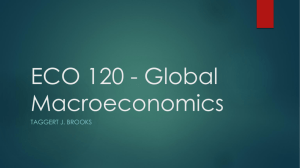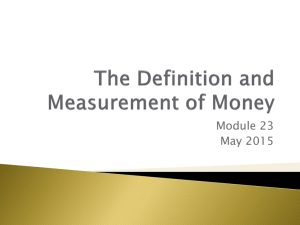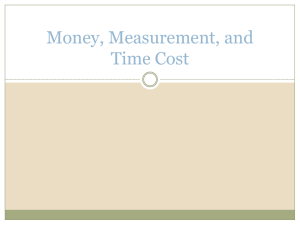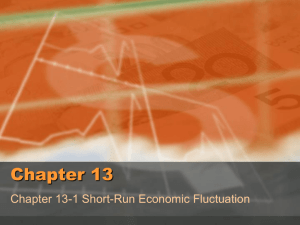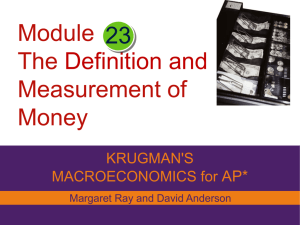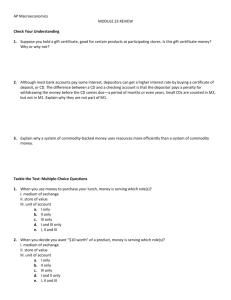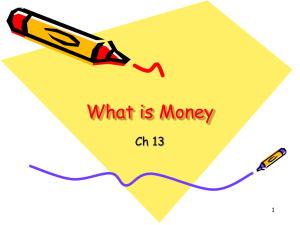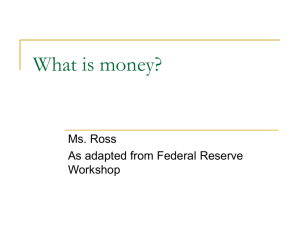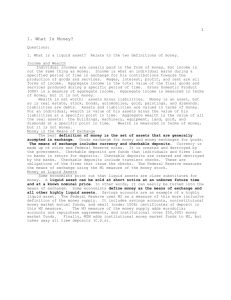Definition and Measurement of Money
advertisement
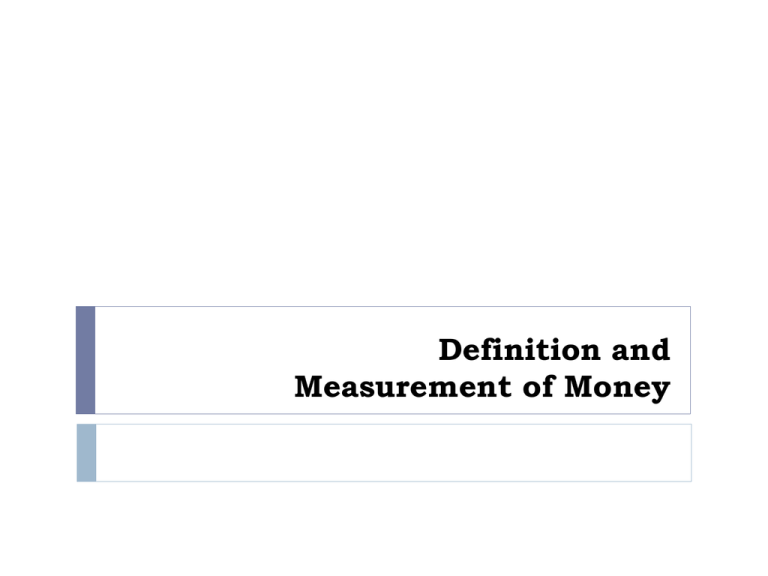
Definition and Measurement of Money Objectives: What is money and what are the functions of it? What are the various roles that money plays in the economy? How is the amount of money measured in the economy? What is Money? What is money? What is wealth? What distinguishes money from other forms of wealth? What is Money? Money is any asset that can easily be used to purchase goods and services. An asset is liquid if it can easily be converted into cash Money consists of cash itself, as well as other assets that are highly liquid. What is Money? Currency in circulation is cash held by the public. Checkable bank deposits are bank accounts on which people can write checks. The money supply is the total value of financial assets in the economy that are considered money. Narrower definition considers only the most liquid assets to be money Currency in circulation Traveler’s checks Checkable bank deposits What is Money? Narrower definition considers only the most liquid assets to be money Broader definition includes all three above plus other “assets” that are “almost” checkable Currency in circulation Traveler’s checks Checkable bank deposits Savings account deposits that can be transferred into a checking account online Money plays a crucial role in generating gains from trade because it makes indirect exchange possible Roles of Money Money plays three roles in any modern economy: 1. Medium of Exchange 2. Store of Value 3. Unit of Account 1. Medium of Exchange A medium of exchange is an asset that individuals acquire for the purpose of trading rather than for their own consumption. Examples: Normal Times – official money of any given country is the medium of exchange Troubled Economic Times – other goods or assets are often used instead 2. Store of Value A store of value is a means of holding purchasing power over time. Money is not the only store of value, any asset that holds its purchasing power over time is a store of value 3. Unit of Account A unit of account is a measure used to set prices and make economic calculations. A commonly accepted measure is necessary in terms of transaction would be harder to determine if there wasn’t one. If transactions are harder to determine, then it would be difficult to achieve gains from trade Types of Money Commodity money is a good used as a medium of exchange that has other uses. Normally gold or silver A commodity-backed money is a medium of exchange with no intrinsic value whose ultimate value is guaranteed by a promise that it can be converted into valuable goods. Advantage over commodity-backed money over simply commodity money like gold and silver, is that it ties up fewer valuable resources Types of Money Fiat money is a medium of exchange whose value derives entirely from its official status as a means of payment. Fiat has two advantages: 1. It doesn't’t tie up any real resources 2. The money supply can be managed based on the needs of the economy instead of being determined by the amount of gold and silver prospects happen to discover Risks: counterfeiting Measuring the Money Supply The Federal Reserve calculate the size of the monetary aggregate A monetary aggregate is an overall measure of the money supply. Near-moneys are financial assets that can’t be directly used as a medium of exchange but can readily be converted into cash or checkable bank deposits. The Time Value of Money Objectives: Why is a dollar today worth more than a dollar a year from now? How can the concept of present value help make decisions when costs or benefits come in the future? The Concept of Present Value Everyone is faced with financial decisions that will have consequences long into the future Time places a role in all economic decisionmaking Paying for College, better salary Going on a cruise, paying off the cruise after you return Borrowing, Lending, and Interest Having a dollar today is worth more than having a dollar a year from now. True? False? True! If you get a new job that comes with a $1,000 bonus, which will be paid at the end of the first year, can you spend the extra money now? Yes, borrow now and repay the debt later You wouldn’t borrow the full $1,000 today though, because a year from now, you have to repay the full amount plus interest Borrowing, Lending, and Interest All it means is that $1,000 today is worth more than having a $1,000 a year from now. Borrower and Lenders know that this allows a lender to charge a borrower interest on loan Borrowers are willing to pay interest in order to have money today rather than waiting until they acquire that money later on Defining Present Value The key to concept of present value is to understand that you can use the interest rates to compare the value of a dollar realized today with the value of a dollar realized later Why the interest rate? Interest rate correctly measures the cost to you of delaying the receipt of a dollar of benefit and, correspondingly, the benefit to you of delaying the payment of a dollar of cost Defining Present Value Example: You are deciding on whether or not to take a job in which your employer promised to pay you a bonus at the end of the first year What is the value to you today of $1 of bonus money to be paid one year in the future? First, you need less than $1 today in order to be assured of having $1 one year from now Any money that you have today can be lent out at interest This turns any amount you have today into a greater sum at the end of the year Defining Present Value r = interest rate (in decimal terms) Amount received one year from now as a result of lending $X today = $X + $X x r = $X x (1 + r) Condition satisfied when $1 is received one year from now as a result of lending $X today: $X x (1 + r) = $1 Amount lent today in order to receive $1 one year from now = $X = $1/(1 + r) This means you will be willing to accept today the amount $X defined by the above equation for every $1 to be paid to you one year from today Defining Present Value Solving the equation r = 0.10 (10%) Value of $X when r = 1.10: $X = $1/(1-0.10) = $1/1.10 = $0.91 You would accept $0.91 today in exchange for every $1 to be paid to you one year from now $X is called the present value of $1 Defining Present Value The present value of $1 realized one year from now is equal to $1/(1 + r): the amount of money you must lend out today in order to have $1 in one year It is the value to you today of $1 realized one year from now Using Present Value Problems with choosing between items is that you have to weight costs and benefits for each but costs and benefits are realized for items at different times Present value is able to convert any dollars realized in the future using the net present value Net present value of a project is the present value of current and future benefits minus the present value of current and future costs
